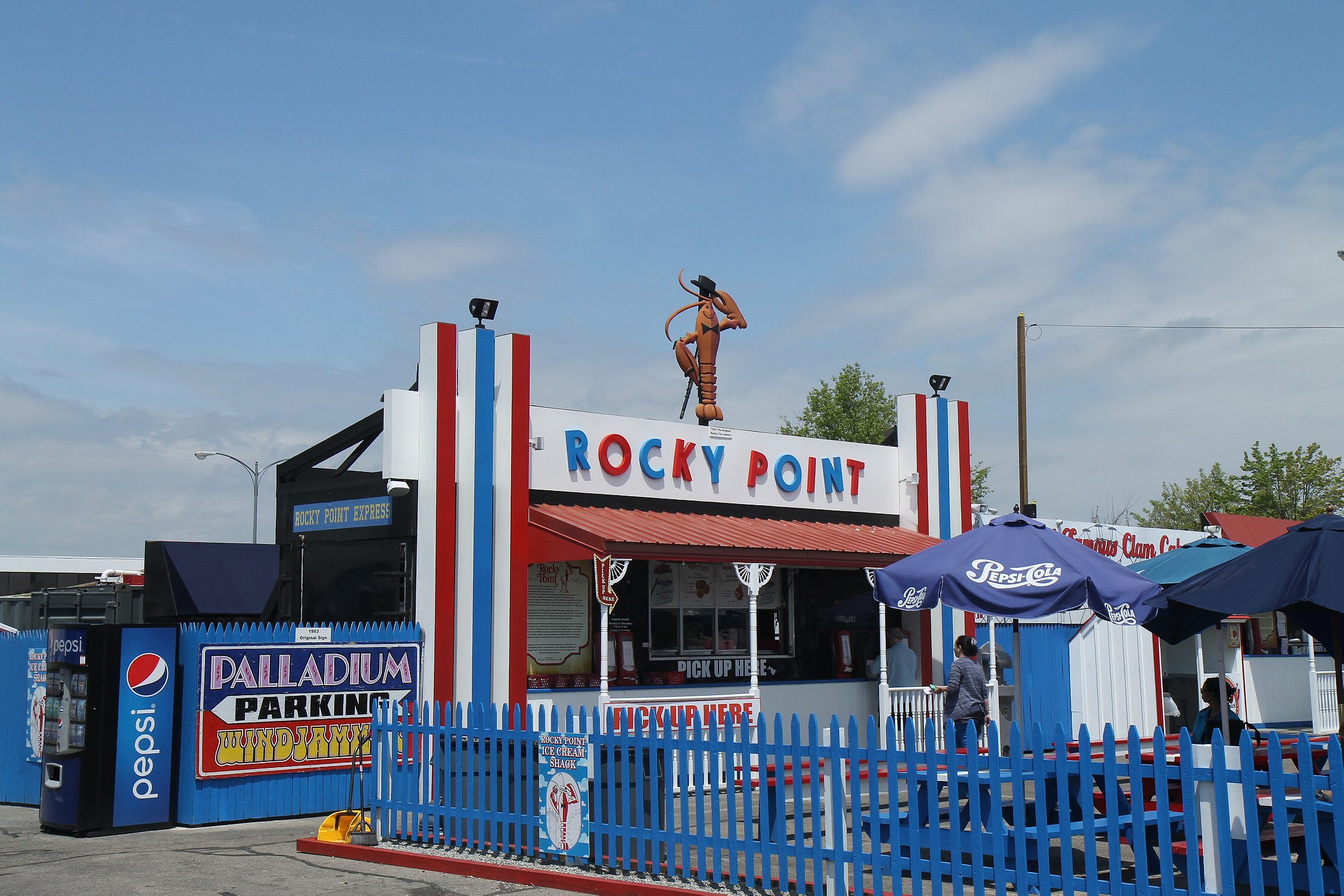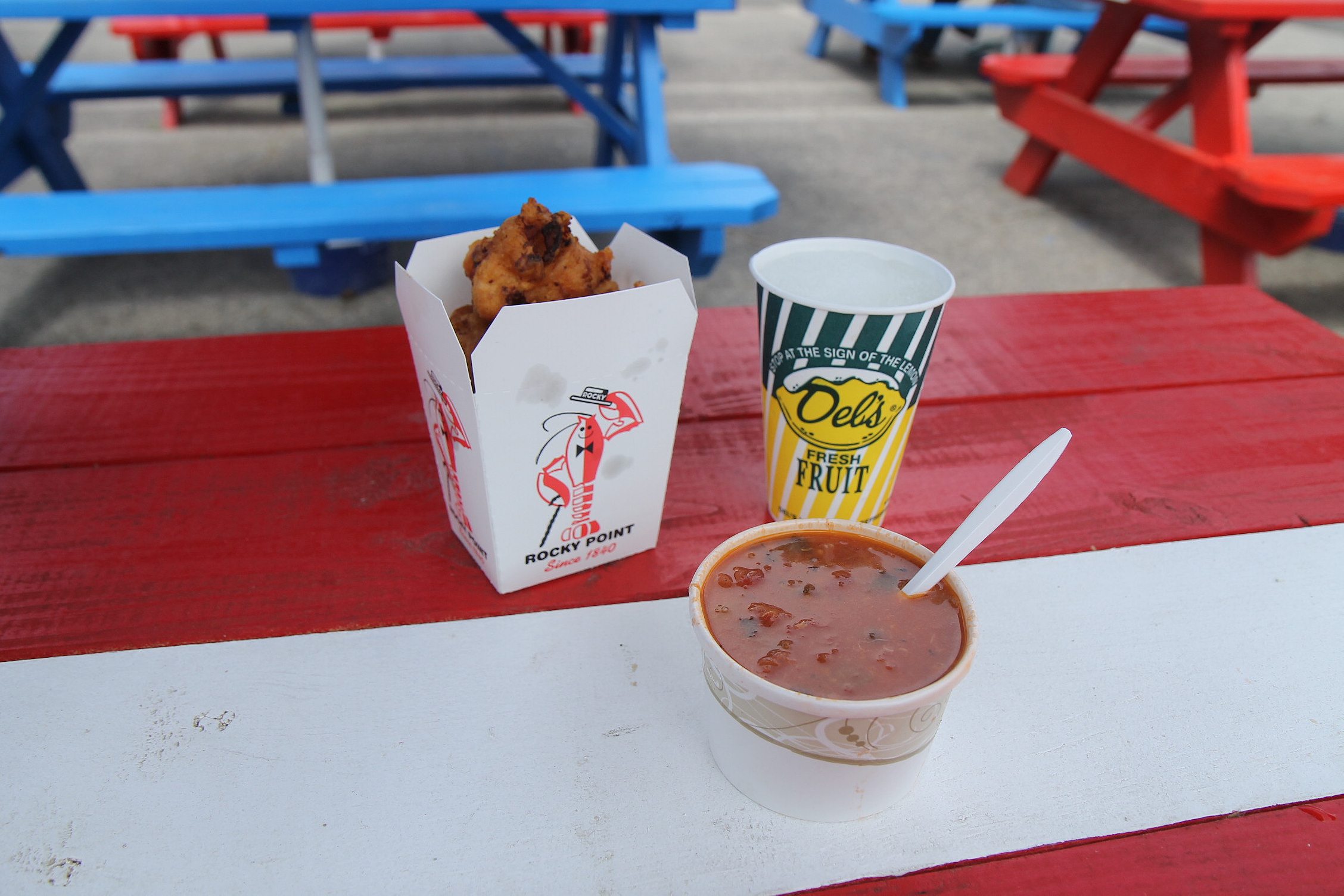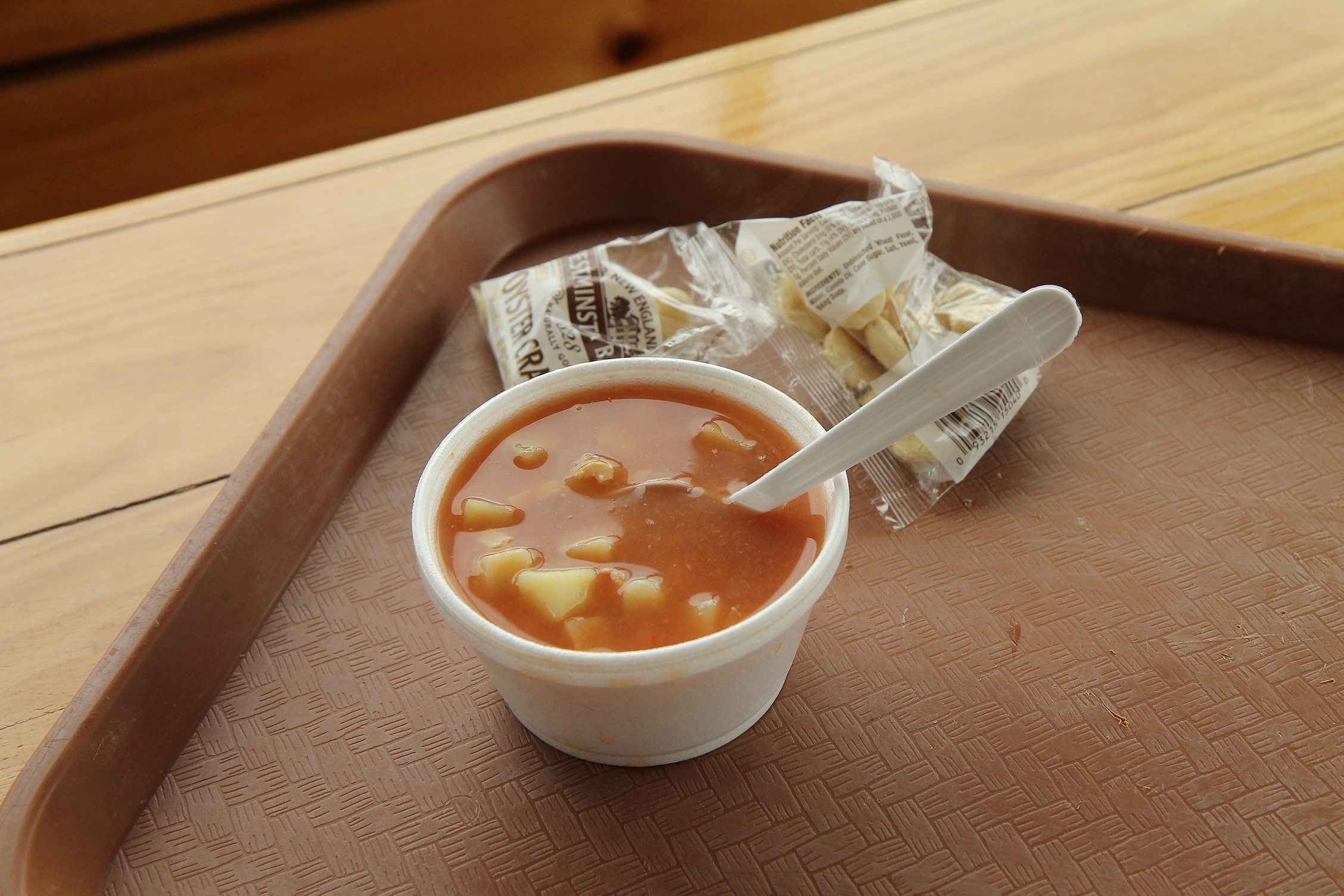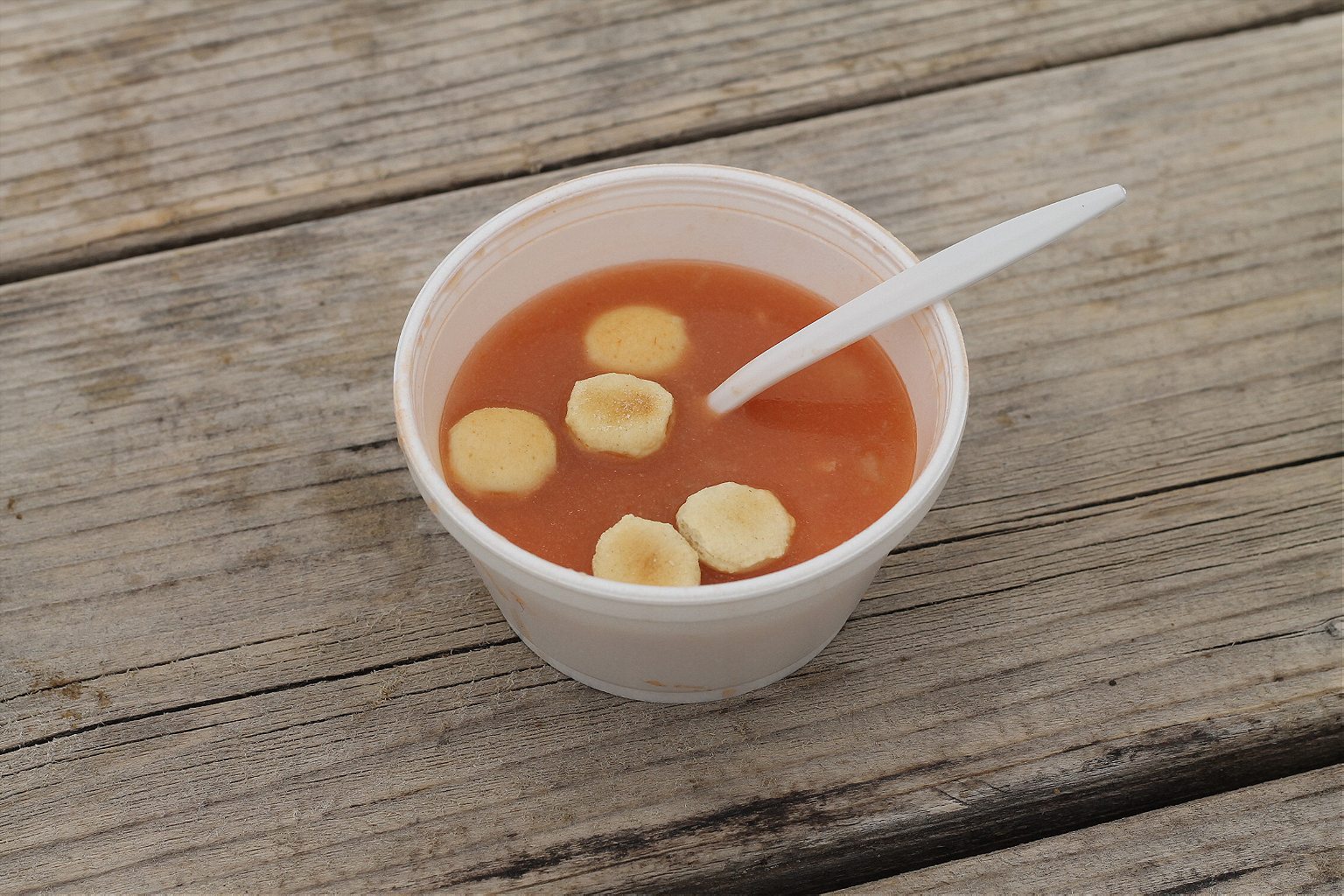Crossing Rhode Island in search of the briny chowder that once defined coastal summers.
All Rhode Islanders of a certain age have fond memories of seafood at Rocky Point. The old-fashioned amusement park operated in Warwick Neck—just south of Providence—from about 1847 to 1995. The terrifying Free Fall ride, as well as the tamer Ferris wheel, offered riders some of the best waterfront views in the state, which is impressive, considering Rhode Island boasts over 400 miles of coastline. My last memory of the park is riding the Corkscrew roller coaster five times in a row at a friend’s birthday party. That day, Rocky Point was so empty that nobody else was waiting in line. It was great fun having the park to ourselves, but it didn’t exactly bode well for business.
The amusement park closed about twenty years ago, and while the Corkscrew may be long gone, one piece of Rocky Point’s legacy lives on. The park didn’t serve the clear-broth chowder known today as “Rhode Island style.” The chowder also wasn’t gluey like the stuff from Boston or chunky, like Manhattan chowder, packed with green peppers and celery and chunks of tomato. Instead, this briny chowder was full of quahogs—a large clam—enriched with tomatoes, paprika, and starch from diced potatoes and Pilot crackers, creating a pink broth.
A sharp, briny kick balanced by a touch of acid from tomatoes.
I first tasted Rocky Point’s chowder on my seventh birthday. My memories of it are obscured by thoughts of roller coasters or getting soaked on the water slides. I was most interested in the rides, but my father insisted I eat a few spoonfuls from his bowl. It was unlike any chowder I’d had before. The sharp, briny kick was balanced by a touch of acid from the tomatoes, and there were no pieces of intimidating parsley or dill floating around on the surface.
I was eventually convinced that only New Yorkers put tomatoes in chowder, and didn’t eat red chowder again for years. But a recent trip home to Rhode Island brought back memories of the food at Rocky Point. I learned that a handful of clam shacks, clustered around Warwick and Narragansett (an idyllic coastal New England town), still served red chowder, so I drove across the state in search of it.
The history of chowder is a murky one. The word itself is likely derived from the French chaudière, or cauldron, but it’s unclear whether French, Nova Scotian, or British fishermen introduced it to the Northeastern United States. “The first chowders were made by fishermen who would be out to sea and use some of their catch to make something to eat,” explains Linda Beaulieu, author of The Providence and Rhode Island Cookbook. “They probably used salt water because fresh water was at a premium.”
The first formal recipe for chowder appeared in a Boston newspaper in 1751. Back then, ingredients usually included fish, seafood, and various vegetables. Milk wasn’t added until the mid-nineteenth century, and it was only occasionally added at that time. Today, white New England clam chowder has conquered much of Rhode Island, served at restaurants and clam shacks across the state.

But nostalgia for the park recently reached high enough levels to warrant a tribute restaurant called Rocky Point Clam Shack, which opened last year. It’s not located on the beach—you’ll actually find it in a department store parking lot on busy Post Road, just minutes away from T.F. Green Airport in Warwick. The location sounds strange until you learn Rocky Point’s food was once so popular that it supported an off-site chowder and clam cakes stand that operated on this same street.
At Rocky Point Clam Shack, the vintage Rocky the Lobster logo greets customers like a long-lost friend. The signs mimic the lettering once found on the park’s gate, and memorabilia from the park is displayed on the walls next to the ordering window. Because my childhood memories of Rocky Point long ago assumed a surreal quality, seeing items long-buried in my memory gives me an uneasy feeling, as though I were about to wake up from a disjointed dream.

At noon on a spring morning, the sun was already beating down on the diners seated at blue picnic tables. The clam cakes (round, golden fritters studded with clam pieces) arrive piled high in adorable takeout containers emblazoned with Rocky the Lobster. Paired with an iconic Del’s frozen lemonade, the combination tastes like summer to a native Rhode Islander like me. But the chowder wasn’t what I expected. The sweet, red broth was packed with chunks of celery, onion, and chopped tomato. It was more like a minestrone soup with pieces of clam in it.
Just a short drive from Rocky Point Clam Shack and only 10 minutes away from where the park once stood, Iggy’s Doughboys & Chowder House also offers a red chowder option. Even on a sunny Monday afternoon in mid-May, the beloved beachfront clam shack has diners waiting in line to order from the take-out window. The red chowder at Iggy’s is mild, with the consistency of a thin tomato soup. It contained chunky potatoes, celery, onions, and greenery that appeared to be parsley. Although it was delicious, it was not Rocky Point Chowder. It was reminiscent of a chunky vegetable soup instead.

Still in search of something resembling the park’s chowder, I drove 45 minutes south along Narragansett Bay towards the fishing village of Galilee. Champlin’s Seafood has operated there since 1932. The downstairs market displays live lobsters, scallops, and clams ranging from cherrystones to quahogs. Upstairs, the restaurant overlooks a fleet of fishing boats and serves clear, red, or white chowder. Their red chowder was exceptionally briny compared to those I tried in Warwick. It was full of perfectly cubed potatoes, shreds of clam, and not much else.

From there, I took Galilee Escape Road through salt marshes and stopped in Narragansett to try the legendary Aunt Carrie’s. The storied clam shack in the shadow of the Point Judith lighthouse is said to be the birthplace of the clam cake, another iconic Rhode Island food. It also serves three types of chowder— clear broth, white, and red. “The base recipe is always the same,” explains Philip Perron, the current manager and the owner’s son-in-law. “It all starts off as clear chowder. All three chowders are based from the same recipe.” The addition of milk turns the chowder white, while adding tomatoes makes it red.
The buttery, red chowder had huge chunks of potatoes and bite-sized pieces of clam floating in the briny broth. It was clearly enriched with tomatoes, but no pieces were visible. Most notably, there wasn’t a speck of celery, just like in the recipe from Beaulieu’s book. “We never put in any celery,” explains Aunt Carrie’s owner, Elsie Foy. “It’s a traditional recipe that we’ve been using for 95 years,” she says.

Carrie Cooper, who founded Aunt Carrie’s in 1920, likely started out serving only clear and white chowder. She had an English and Scottish background and grew up on a farm in Connecticut, where milk and potatoes were plentiful. Foy, who has worked at the clam shack since 1969, recalls serving three types of chowder. But her cousin, Avis, now in her late 80’s, maintains there was no tomato chowder when she worked there from 1938 until 1944. She suspects the Ocean State’s large Italian-American population is responsible for putting tomatoes in chowder.
Tomatoes are typically associated with Manhattan-style chowder, but tomato clam chowder recipes appeared all over New England and the New York area throughout the nineteenth century and early twentieth century. Some food historians believe Neapolitan immigrants in New York’s Little Italy were the first to use tomatoes in chowder, while others attribute it to Azorean immigrants in Rhode Island.

At almost 20 percent of the population, Italian-Americans actually comprise Rhode Island’s largest ethnic group. In fact, the Good Housekeeping Everyday Cook Book from 1903 contains a recipe for Rhode Island Clam Chowder that is quite similar to the one served at Rocky Point. Also, the date of its publication is a little late to match Portuguese-American immigration patterns, but it coincides nicely with when Italians began flooding into the Providence area at the turn of the century. Beaulieu concurs, saying, “The Portuguese had kale soup, but the Italians and the French seemed to put tomatoes in their soup. Whoever ran the Shore Dinner Hall was probably Italian.”

Beaulieu is referring to Rocky Point’s gigantic Shore Dinner Hall, which was a cross between a feeding trough and church rectory. A cacophony of carnival music and seagull squawks bounced off the Hall’s garish pink walls while salty sea breezes mingled with the smell of steaming clam cakes served straight from the fryer. It could hold up to 4,000 diners seated at long, communal tables, covered in white paper for easy cleaning. According to Rocky Point Park, a history of the place by David Bettencourt and Stephanie Chauvin, it was once estimated that the Shore Dinner Hall served 500,000 gallons of red chowder per year.
Just like the first chowders that fishermen once made, Rocky Point’s version is also a reflection of place and those who created it. Bill Chatto, who worked at the Shore Dinner Hall from 1963 until 1966, says that the manager of the Shore Dinner Hall (and the entire park) was indeed Italian-American. He credits Corrado “Conrad” Ferla with the massive hall’s success. “The operation was like a well-oiled machine,” he recalls. “Conrad was the brains behind the operation and ran a tight ship. He was a tough guy to work for, but always fair.” His brother, Vincent Ferla, owned the park, and Conrad managed it until 1986.

About ten years later, the Corkscrew and other amusement park rides were sold at auction. The Shore Dinner Hall became part of a ghost town. The pink paint peeled from the walls while stainless steel cookware and those long tables and chairs were left to rot. The decrepit structure was left to the mercy of penetrating winter coastal winds until it the property was finally cleaned up in 2011 for use as a public park.
Today, teenagers who never knew the property in its previous incarnation sunbathe on the green expanse of newly planted grass that has overtaken concrete. They’re about the same age as Bill Chatto was when he worked at the Shore Dinner Hall, and it’s worth remembering that Rocky Point’s beloved chowder was in no way gourmet fare if kids like these were making it for such a huge crowd.
Like the first soups made by fishermen, Rocky Point’s chowder was a product of its place and time. Italian-American cooks likely created it, but carnival music, amusement-park rides, and sitting elbow-to-elbow with family and friends made it memorable. Rhode Islanders can still drive across the state in search of a replica, or even cook one in their own kitchens. But a few Rocky Point relics, like the old arch gate, still stand, reminding us the chowder will never taste exactly the same.